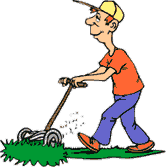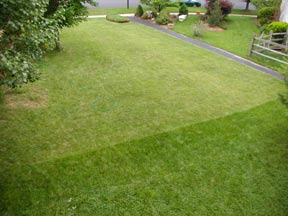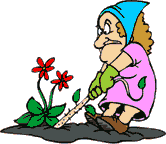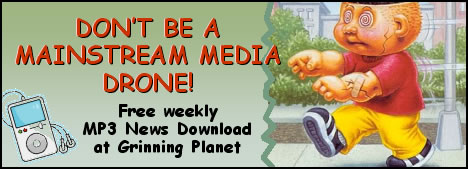|
Though pride is one of the Seven Deadly Sins, we won't hold it against you if you are proud to having a nice-looking lawn. Conversely, you may look at your patchy lawn and get feelings of woe and dread.
 For both of these "lawn personality types"—and all those in-between—our article today is a hopperful of useful natural lawn care tips that will help you not only have a great-looking lawn but also avoid the toxic array of lawn chemicals that lawn-care companies (and the US EPA) have falsely led you to believe are necessary and safe to apply to your lawn. Most of them are toxic to you, your kids, and your pets; and since rain waters will always carry a portion of these chemicals into nearby streams and ponds, they're bad for wildlife as well.
For both of these "lawn personality types"—and all those in-between—our article today is a hopperful of useful natural lawn care tips that will help you not only have a great-looking lawn but also avoid the toxic array of lawn chemicals that lawn-care companies (and the US EPA) have falsely led you to believe are necessary and safe to apply to your lawn. Most of them are toxic to you, your kids, and your pets; and since rain waters will always carry a portion of these chemicals into nearby streams and ponds, they're bad for wildlife as well.
So, put on your sun hat and get ready for some great lawn care tips.
Many people like to think of their lawn as their own personal putting green. But close-cropped putting greens are among the most intensively managed—watered, fertilized, and chemically sprayed—patches of land in the world. Your grass will be much happier (and healthier and greener) if you loosen your stranglehold on it, and you'll be able to spend more time relaxing instead of working on your lawn.
The first step to this new paradigm is to raise the height of your mower. If you live in southern states, you'll want something around 2-1/2 inches high; in shadier northern states, 3-1/2 inches is recommended.
Taller grass has multiple benefits:
- The larger mass of grass blades makes the grass look greener overall, and problem spots will look less obvious than they did when you were mowing at putting-green heights.
- The extra green on top delivers more nutrients to the grass' roots and helps them grow deep, giving the grass better access to water and making it more drought-tolerant. Deeper roots also mean better access to soil nutrients.
- The thicker root mass and the taller green parts work to crowd out weeds by keeping weed seeds from germinating and crowding out any unwanted plant pests that do manage to germinate.
- Taller grass leaves help keep the sun off the soil, helping to preserve its water content.
- Your longer-cut lawn will require less mowing. (Cutting the grass short stimulates the plants to try to grow faster to make up for their lost greenery.)
While cutting higher is beneficial, certain fine-leafed grasses tend to fall over or get pushed down by the lawnmower, resulting in uneven cutting. If you're finding this is the case, try lowering the mower deck by a half-inch at a time until you find the preferred height. Alternately, mowing your lawn a little more often may also help allow you to maintain a tall "cut height" but still avoid the falling-over problem. If only a few problem areas suffer from falling-over grass blades, doing a second or third pass
|
over these areas can help touch them up. This usually works, especially when the additional passes are done at different angles.
Finally, most experts recommend not cutting off more than a third of your grass at any one time—doing so may stress the grass. So, if you're going for a cut height of 3-1/2 inches, you'd want to mow the lawn by the time it gets to about 5 inches tall.
|
 |
The section of lawn in the top of the photo is a typical chemical-treated suburban lawn. The greener section of grass in the lower portion of the picture is a natural, chemical-free lawn cut to a higher height. |
|
Somehow the idea got started that leaving the cut grass on your mowed lawn will smother it. Well, put that sham lawn care tip on the compost pile! Remember that grass clippings are 10% nitrogen, and you know that nitrogen is a main component of lawn fertilizers, so... Leave the grass clippings on your lawn to decompose and return their nitrogen to the soil for your lawn to reuse. Organic Gardening magazine notes that a season's worth of grass clippings will contribute almost 2 pounds of nitrogen per 1,000 square feet of soil—half of the lawn's annual fertilizer needs. Mulched grass clippings also shade the surface of the soil and make it harder for weed seeds to germinate.
|
You can make sure the you don't end up with a heavy layer of grass clippings on top of your lawn by:
- Using a mulching mower to chop up the grass clippings finely as you are mowing. In heavy areas of the lawn you may need to make a couple of passes with the lawnmower to get them chopped up enough. (That may seem like extra effort, but it's less extra effort than bagging!)
|
|
A CLIPPING ON CLIPPINGS |
|
William Dest, Ph.D., associate professor emeritus of turf grass studies at the University of Connecticut, compared lawns where the clippings had been left behind with lawns where they had been removed. He found that the lawns with the clippings had:
-- 45% less crabgrass
-- up to 66% less disease
-- up to 45% more earthworms
-- 60% more water reaching plant roots
-- 25% greater root mass
-- 50% reduced need for nitrogen fertilizer
For more, see Organic Gardening's lawn care page.
|
|
- Cutting the grass often enough that the clippings aren't so thick that no amount of repeated chopping will make them disappear into the lawn. (This is not usually a problem unless you've let your lawn go to the point where your neighbors wonder what's wrong with you.)
Mulching your grass clippings will supply most of the food your lawn needs. By reducing or eliminating your use of chemical fertilizers, you'll reduce the amount of polluting runoff that rains carry from your lawn to local waterways.
Oh, and in case you're thinking that following the above procedures will mean that your lawn will eventually suffer from thatch buildup—it won't. Thatch results when you've used chemical fertilizers and pesticides on your lawn so much that you've killed most of the organisms in the soil than would normally break down the dead grass clippings. Freshly mulched grass clippings are a feast for earthworms, who are instrumental in breaking down thatch and aerating soil.
It's easy to wish that the only care a lawnmower needs is to check the oil once in a while and give it a tune-up once every decade. But the mower blade is something that needs attention at least once a season, and two or three times might even be necessary, depending on your use. Sharpening the blade will make it easier for your mower (and you) to cut the grass and, more importantly, will avoid tearing the grass and wounding the grass blades, which makes them more susceptible to infection and evaporative loss.
Your local power-equipment dealer or lawnmower shop can sharpen your blade for a small fee, as can many hardware stores, but investing in your own sharpening wheel will save you money in the long run.
Most turf grasses prefer soil that is slightly acidic to neutral. Many weeds, on their other hand, prefer acidic or alkaline soils, so getting the pH balance right can optimize conditions for your grass and make them less favorable for weeds.
If you have naturally acidic soil, sweeten it with lime or wood ash. Hardwood ash has about 50% to 65% of the alkalinizing power of lime, so if you go that route, you'd use half again more of the ash.
|
STAY CURRENT WITH THE LATEST AUDIO DOWNLOADS |
|
CATEGORY: AGRICULTURE — 08.FEB.2015
 Agroinnovations Podcast
Agroinnovations Podcast
Food Hubs —
Erik Hoffner talks about the local food movement, focusing on the exciting development of "food hubs" that are springing up across the country. He describes the opportunities of scale and collaboration food hubs and related innovations are providing for local food entrepreneurs. Also discussed are energy cooperatives, fair trade, and the prospects for sustainable agriculture to replace the industrial model.
Go to page |
Download/listen
49:36
Original Show Pub Date: 19.Jan.2015
CATEGORY: AGRICULTURE, FOOD, GMOs — 09.DEC.2014
 Food Sleuth Radio
Food Sleuth Radio
The Seed Underground—A Growing Revolution to Save Food —
Janisse Ray discusses the threat to seed sovereignty posed by multinationals like Monsanto, which are endeavoring to lock up the food-related profit stream from field to fork by owning the means of production. She explains how activism and seed saving both play a role in the fight.
Go to page |
Download/listen
28:15
Original Show Pub Date: 13.Nov.2014
CATEGORY: AGRICULTURE, LABOR ISSUES — 03.DEC.2014
 Democracy Now
Democracy Now
Food Chains: New Film Tracks How Immokalee Farm Workers Won Fair Wages from Corporate Giants —
A new film, Food Chains, documents the groundbreaking partnership between farm workers, Florida tomato farmers, and some of the largest fast-food and grocery chains in the world. Twelve corporations have agreed to join the Fair Food Program, including McDonald’s, Taco Bell and WalMart. Participants agree to pay a premium for the tomatoes in order to support a "penny per pound" bonus that is then paid to the tomato pickers. Soon, the Fair Food label will appear on Florida tomatoes at participating stores. Gerardo Reyes-Chavez, a farm worker and organizer with the Coalition of Immokalee Workers, discusses the issue.
Watch |
Download/listen
9:32
Original Show Pub Date: 21.Nov.2014
 MORE
MORE
Get more audio clips on gardening, agriculture issues, and many more topics in Grinning Planet's biweekly
downloadable audio news feed.
|
Before you use either, though, use a soil test kit to determine the pH of the soil under your lawn. It's better to edge your way up to the desired pH over a few applications than to overshoot and then face the more difficult task of bringing the pH back down. Both lime and ash are best applied in the fall—this enables the material to break down over the winter so the soil is improved for the next season's growth. But if you test your soil in the spring and it's too acidic, go ahead and do an application.
It may be painful to see those big plugs of your sod coming up when you run an aeration machine over your lawn, but experts insist that doing this every couple of years allows air, water, and nutrients to get deep into the root zone of grasses. Aerating also helps eliminate thatch.
Your latitude and average annual rainfall level will govern what type of grass you choose for your lawn. Those in the northern climes usually do better with "cool season grasses," while those in the hotter southern region do better with "warm season grasses." Those in the middle don't have such clear-cut situations—your best bet is to ask your county extension agent, local nurseries, or even neighbors who seem to have good-looking lawns. (Beware, however, of that three-eared neighbor who seems to believe that Better Living Through Chemicals applies to his lawn.)
Finally, if you live in a very dry area, you probably should not be attempting to grow a lawn at all. Try permaculture instead. In the long run, it will save you time and headaches, not to mention water.
According to lawn-and-garden guru
Mike McGrath
one should time feeding and reseeding based on the needs of the particular variety of grass:
- Cool season grasses such as perennial rye, Kentucky bluegrass and the fescues should be sown in mid-August to mid-September so the seeds have warm soil in which to germinate but the young grass shoots have rapidly cooling air (in which they thrive). McGrath also recommends fertilizing in the fall with an inch of compost, watered in; and, if you aren't reseeding, some corn gluten meal, which will also help suppress fall weed germination.
- Warm-season grasses like zoysia, Bermuda, and centipede should be sown and fed in the spring and summer but not in the fall.
For feedings, use a natural, slow-release fertilizer or fine compost.
|
Most lawns need about an inch of water per week. If not enough rain has fallen to quench your lawn's thirst—a rain gauge can be useful here—use one long, soaking watering (rather than a shorter watering every day) to give your lawn its week's worth of "rain."
If you have to water, do it in the early morning. Watering in the evening invites disease.
Finally, remember that most grass is designed by nature to work around droughts by reducing growing activities when water is in short supply. But if you overuse nitrogen fertilizer or your lawn isn't particularly healthy to begin with, the grass' natural abilities may be defeated.
|
LAWN CARE TIP BONUS
The Ice Man Slippeth |
|
Slipping or sliding on icy walkways can cause falls and damage your body, but the de-icing products you use to solve the problem can damage your lawn and border plants. They can also corrode concrete and metal and harm pets when they get the substances on their skin or ingest it while licking their paws.
The Green Guide recommends forgetting about the deicer and using sand to make ice less slippery; but if you must have a deicer, they recommend the brand name "Safe Paws," which is safe for pets and the environment. If you're still set on using a traditional, salt-based deicer, see the You Bet Your Garden special report,
How to Protect Your Plants When You Melt Sidewalk Ice.
|
|
We don't really know why people hate clover in their grass. Maybe we can persuade you to love it by summarizing its benefits:
- Clover fixes nitrogen from the air, providing free fuel for the turf grass with which it peacefully coexists.
- It adds to the greenness of your lawn (except, of course, for the relatively brief part of the year when clover flowers).
- The clover's flowers provide an important source of nectar for honeybees, bumblebees, and other types of beneficial bees and pollinating insects.
- Earthworms, which are great for soil in general, like the presence of clover.
- Clover is disease-resistant and avoided by most common turf pests.
- It's drought-tolerant.
|
Simply put, clover is part of a healthy lawn, adding to the stability of your "lawn system."
|
|
Fork Over the Clover |
|
Clover heads can even be eaten in salads, with nutrients that include protein, calcium, phosphorus, and magnesium.
|
|
But if all that doesn't want to make you abandon your dubious mantra "Must Kill Clover," then at least get rid of the clover in a sane manner. By this we mean NOT by using products that contain 2,4-D, a nasty herbicide that can have ill effects on your pets, your kids, and you. Instead, try a multi-year program of applying natural corn gluten meal, which will have the added benefit of killing all of your other seed-based weeds and adding nitrogen to the soil, too. Remember that corn gluten meal will suppress germination of grass seeds as well, so time your applications away from reseedings. For more information about corn gluten meal, see this
Eartheasy article
or this You Bet Your Garden
Question of the Week.
Not many people want a yard full of dandelion puffballs or crabgrass. But there's a difference between not having a weed-infested yard and having a lawn that has only one species of plant (grass). Paul James of Gardening By The Yard points out that 100% weed control is nearly impossible and not even particularly desirable for a healthy lawn. Some weeds provide food or habitat for beneficial insects, which are
 good for controlling pests in your lawn, garden, and other planted areas. As mentioned above, the "weed" clover fixes nitrogen from the air and helps fertilize your turf grass.
good for controlling pests in your lawn, garden, and other planted areas. As mentioned above, the "weed" clover fixes nitrogen from the air and helps fertilize your turf grass.
Still, we understand that some weed control is necessary, and we will address specific weed control strategies in our upcoming article on organic lawn care.
"Don't get overly stressed" is not only good advice for our attitude towards weeds in our lawn, it's a pretty good way to approach lawns in general. To misquote some ancient Greek with a not-so-hot lawn, "Pride goeth before a fall and before having a heart attack over the appearance of the lawn."
|
This lawn care tips article is part 1 of a two-part series. The next issue covers Organic Lawn Care and is designed to complement the information presented here. Then you will have 100% of the information you need to have a great-looking, chemical-free lawn. The stress-free part is up to you!
Know someone who might find this Lawn Care Tips article helpful? Please forward it to them.
Books:
More articles and resources on....
Get Grinning Planet free via email
|
|
|


